Abi-tanti. The migrating multitude
Launched in 2000 and considered a work in progress, Abi-tanti . The migrating multitude configures a multitude of objects in the form of humanoids, each marked by a different exterior appearance achieved by assembling heterogeneous materials in a vast chromatic range but on a shared wooden base (equivalent to DNA) and related to each other by families.
The project, which has involved thousands of children and adults in Italy and in the world, starts from play to call into play the concepts of identity and difference, the encounter with otherness, with difference, the foreign in foreigner, the being that comes to us from another world, an extra-terrestrial and perhaps robot. Abi-tanti . The migrating multitude is intended for the public square seen as Agora, a democratic place for meeting and comparison.
The travelling installation has, since the start of its tour in Turin in 2000, expanded, travelling throughout Italy and extending up to Australia. Among the many towns visited are Alessandria, Biella, Milan, Naples, Reggio Emilia, Rimini, Rivoli, Salerno, Sassuolo, Trento, Udine, Vinci (FI), and aborad Melbourne, Paris, Grenoble. A continuous migration that refers to going beyond the idea of border and barriers separating individuals and peoples, in touch with the notions of the present time that require new thinking and fresh ways of being together, to plan a future open to peace and hope using the cultural tools of art and creativity.
















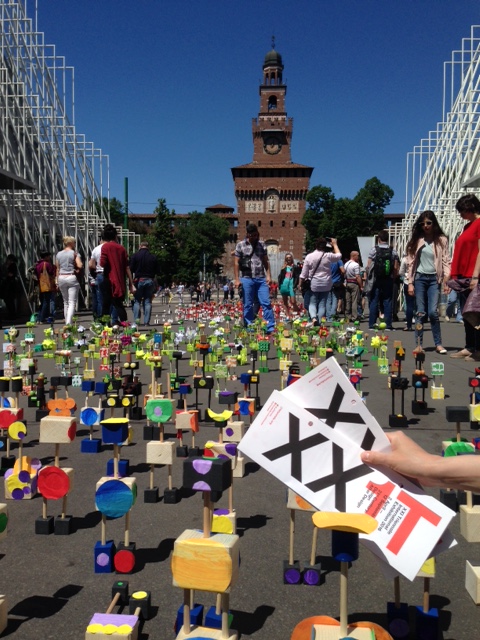







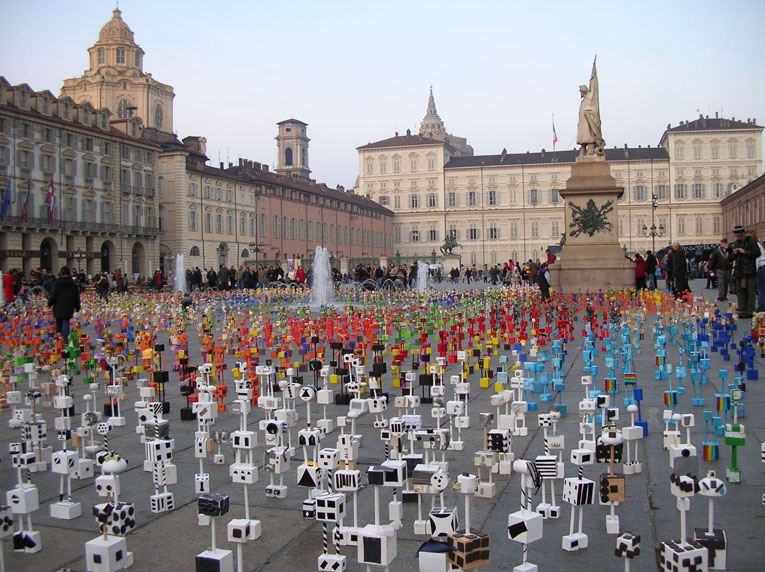





International collaborations
Over the years, the Education Department has developed a network of collaborations without borders.
The Education Department was invited by ISV Independent Schools Victoria of Melbourne to be a partner of the Arts Learning Festival in Melbourne in its first edition 2017 and for the second one, in 2019: it was selected to represent Italy at the Festival after a research by Project Zero for the Harvard Graduate School of Education, Senior Director Howard Gardner, the famous theorist of multiple Intelligences . The University of Melbourne has also invited the Education Department to participate in a new research platform on the theme of contemporary transnational identities, with St. Andrews University, UK, Immigration Museum and the Italian Institute of Culture of Melbourne, MACRO Rome and other international museums.
In June 2017, it presented together with Stalker Teatro the participated performance “Steli” in the prestigious London Festival “Greenwich and Docklands International Festival”, already proposed as part of the Zonarte program at Artissima 2013. Also in 2017 the Education Department participated in the international Kids Guernica network. The painting action realized has thrilled the team of the Kids Guernica museum of Nagasaki visiting the Castello di Rivoli: the canvas has officially become part of the upcoming exhibition at Nagasaki and the international tour of Kids Guernica.
In 2012-2013, an important educational project was shared with the Musée du Louvre in Paris – DPPEA, in relation to the great Parisian exhibition of Michelangelo Pistoletto, at the Louvre since April 24, 2013. Thousands of people attended the final event that it took place at the Louvre and the Tuileries Gardens on 8 and 9 June 2013.
Furthermore, in 2012 the Zonarte group was invited to Kassel in the prestigious dOCUMENTA headquarters (13) to propose a workshop within the program organized by the collective Critical Art Ensemble in the Railway Lecture Hall.
La ville en Commun is instead the title of the special project for EVENTO 2011 Biennial of Bordeaux: the Education Department, the only Italian museum department was invited by Pistoletto, EVENTO 2011 Artistic Director, to implement an educational and participatory project in which spectator becomes the protagonist, to experience art in multiple spaces in the city of Bordeaux. The latter have become places of experimentation dedicated to contemporary creation, with 10 days of non-stop activity for all citizens, young people, adults, families.
In 2011 there was also the presentation tour of the project, unique in the world, Silence speaks about art. Dictionary of Contemporary Art in Italian Sign Language: in addition to numerous events in Europe, in October it was presented at the Institute of Italian Culture in New York, as part of the week dedicated to Italian Culture in the world.
Finally, among the many international experiences, it should be noted that, on the occasion of the 30th anniversary of the Pompidou Center in Paris, the Education Department was invited as the only museum department to take part in the Fi’Art International Festival of art pour jeune public. the audience of young people and families in the Center and in the Beaubourg square. A great collective event attended by over 3,000 people.
There are also collaborations with Metropolitan Museum New York, Museum of Contemporary Art Oaxaca, Mexico, Galerie Nationale du Jeu de Paume, Paris, Kunstmuseum Bonn, nKA – ICA – Independent Cultural Association, Belgrade, Tate Liverpool, Tate Modern London, Stedelijk Museum Amsterdam , Chester Beatty Library, Dublin, funded Joan Mirò, Barcelona.






















Third Paradise
“What is the Third Paradise?
It is the fertile union between the first and second paradise. The first is that in which the intelligence of nature completely regulated life on earth. The second is the artificial paradise, the one developed by human intelligence through a slow process that has become, over the last centuries, increasingly intrusive. (…) It has formed an artificial world that continues to grow, consuming and spoiling the natural planet. The danger of a tragic collision between these two spheres is now announced in every way. The whole project of the Third Paradise is conceived around the universal need for human survival. It can only be realized through an evolutionary step in which the human mind finds ways to co-exist with nature’s intelligence.
The Third Paradise is the new myth that leads everyone to take personal responsibility in this historical transition (…) ”
(Michelangelo Pistoletto).
The sign-symbol designed by Pistoletto to represent the Third Paradise inscribes a circle in the infinite line, thus evoking the cycles of regeneration of matter and the circularity of time. The Third Paradise has become a great collective action, through the collaboration between the Education Department Castello di Rivoli Museum of Contemporary Art, the Education Office of Cittadellarte and CiAL: the theme has been declined in happenings attended by thousands of people, children and adults, in many cities, to propose a message of respect towards nature and urban spaces, through a creative involvement that places art at the center of responsible social transformation.
In the collective actions the symbolic shape was drawn starting from aluminum cords, material recyclable infinite times, to stimulate the assumption of collective social responsibility and the reflection on issues of environmental sustainability.


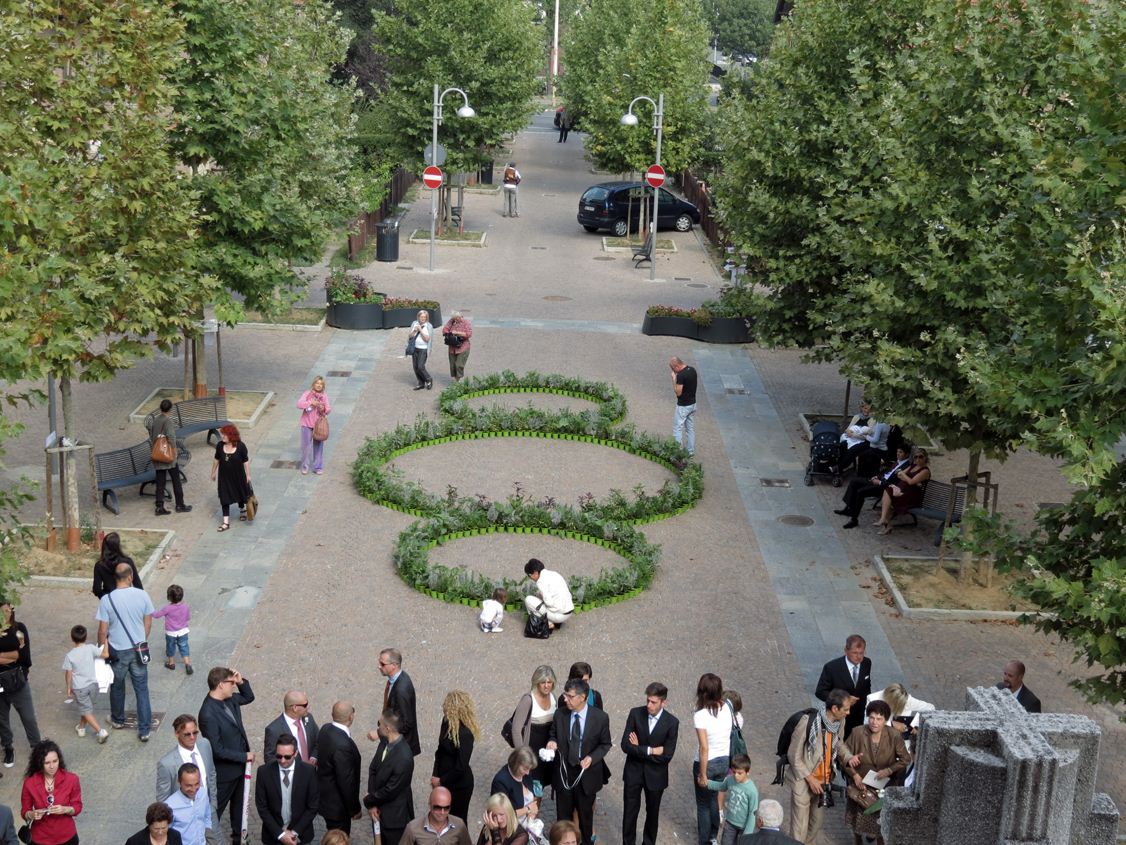












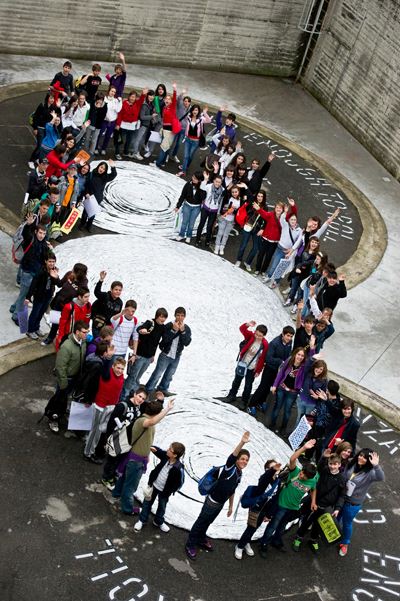


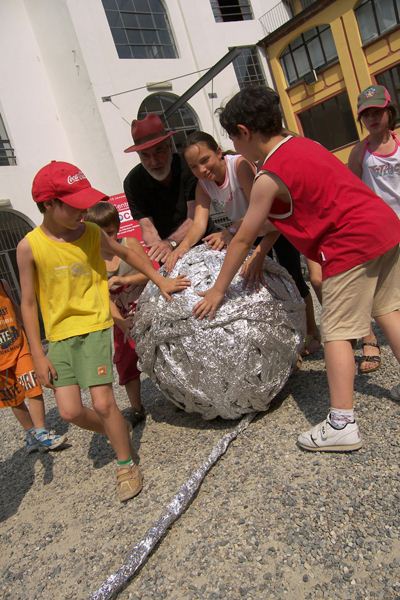




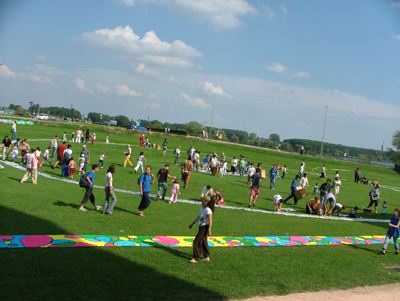





Flying carpet
Flying Carpet is a project that has been running for several years and has contributed to the improvement of an entire district in the centre of Turin characterised by a high immigration rate, San Salvario: launched in 1996 in the Scuola dell’Infanzia Municipale Bay (an infants’ school) and subsequently extended to all of the district’s schools, it makes use of the specific contents of contemporary art, the international nature and recognition of the single individualities, as tools for social inclusion.
Through the metaphor of the carpet, the project promotes relations between individuals, children and adults to encourage integration, a sense of belonging and culture.
Identity and difference qualify the experience that places the individual at the centre, alternating moments of reflection with others of experimentation, in order to effect a process of inclusion and comparison over a number of years within the new social context, one that is lively and varied. As part of the project, which sees the participation of teachers, operators, pupils and parents, activities are arranged both in the Museum and in school for the entire school year, together with concluding events offering significant moments for school life and the district.
Among the most evident results has been the improvement of the spaces used daily, as documented by the numerous wall drawings on the facades, in the schools and community spaces, such as the Casa del quartiere. A typical feature of the project is the annual Festa del bianco (White festival) in the Scuola dell’Infanzia Bay, which regularly returns like light in winter to remind us that producing light is equivalent to knowing (or recognising): another pretext to create significant opportunities for meeting beyond differences in culture, customs and beliefs, in order to experience these differences as riches.







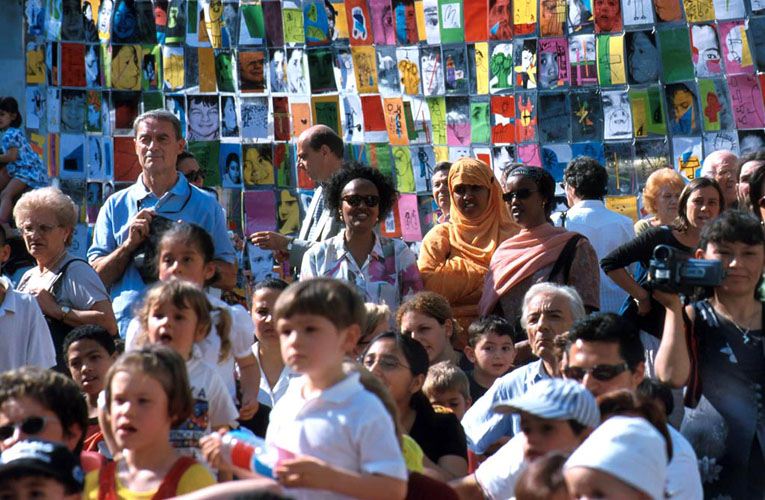
Cantiere dell’arte
Il Dipartimento Educazione è stato invitato nel 2012 dalla Fondazione Medicina a Misura di Donna a collaborare al progetto nato per affiancare gli enti pubblici nel miglioramento e nell’umanizzazione degli ambienti di cura a partire dall’Ospedale Sant’Anna di Torino.
A fronte dei più recenti studi sulla relazione tra arte, bellezza e ben-essere, la Fondazione ha avviato partnership con le eccellenze culturali torinesi che hanno accolto l’invito a realizzare progetti sociali nell’Ospedale, tra le quali il Dipartimento Educazione del Castello di Rivoli Museo di Arte Contemporanea.
La Fondazione ha concepito un percorso che coinvolge dipendenti, pazienti e familiari, in incontri ed esperienze attraverso le arti, in linea con la metodologia partecipata che ha reso noto il Dipartimento Educazione nel mondo, che portino ad una trasformazione tangibile del luogo di cura ad opera di chi lo anima.
Così, dal 2012 ad oggi sono stati realizzati variopinti wall drawing in molti ambienti dell’Ospedale, fino a configurare un vero e proprio “cantiere dell’arte”: interventi strutturali nelle aree considerate prioritarie, come ingressi, scale, sale d’attesa, ambienti nei quali sta fiorendo un meraviglioso “Giardino perenne” dipinto sulle pareti grazie al progetto a cura del Dipartimento Educazione, e al fondamentale coinvolgimento della popolazione dell’Ospedale. Un work in progess al quale ha partecipato anche il Maestro Michelangelo Pistoletto, e che proseguirà con ulteriori interventi per rendere sempre più vivibili e accoglienti spazi altrimenti percepiti dai pazienti e dalle loro famiglie come grigi, freddi e distanti.
Per approfondimenti sul percorso completo
sant’anna cantiere arte con immagini
Inoltre il Cantiere dell’arte, che si configura sempre più come un progetto nomade, dall’Ospedale Sant’Anna si è ampliato ad altre sedi, come il Polo Sanitario di Avigliana, l’Istituto dei Sordi di Pianezza, il Teatro Ariberto di Milano, la Scuola Barolo di Altessano e l’Istituto Sant’Anna di Moncalieri in collaborazione con Opera Barolo – solo per citarne alcune.






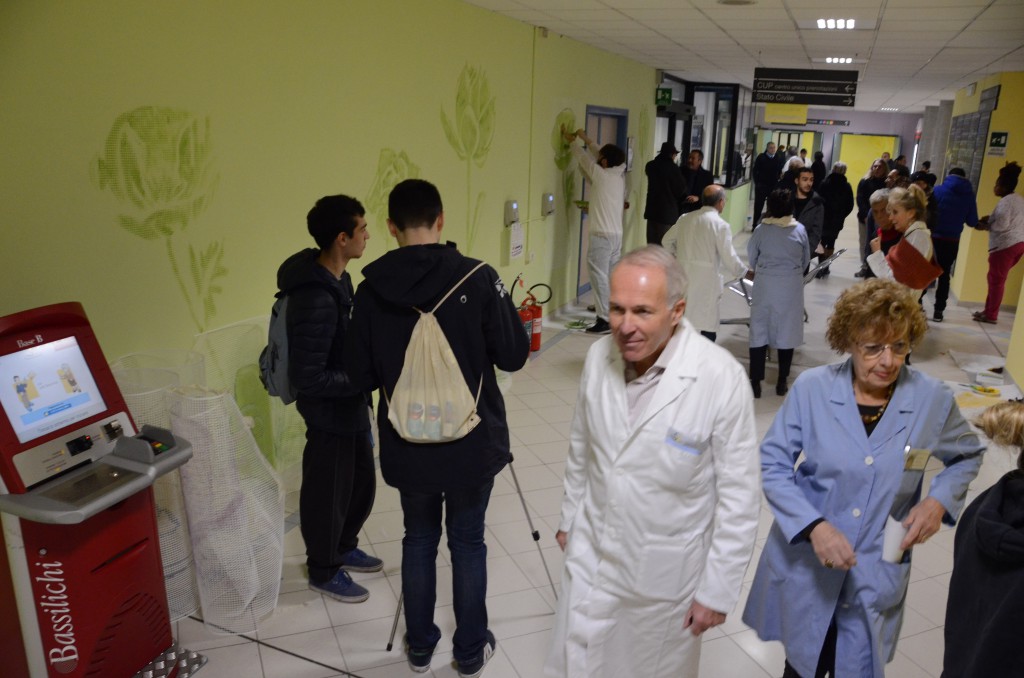





















Zonarte
ZonArte. The space and time in which the public can meet contemporary art
Coordinated by the Education Departments of the Castello di Rivoli Museo d’Arte Contemporanea, Cittadellarte Fondazione Pistoletto Fondazione Merz, GAM Galleria Civica d’Arte Moderna e Contemporanea, Fondazione Sandretto Re Rebaudengo, PAV – Parco Arte Vivente and supported by the Fondazione per l’Arte Moderna e Contemporanea CRT, ZonArte is a network working to encouraging public interest in contemporary art. In 2017 ZonArte curated the publication of the Manual of education about contemporary art, which includes the results of the first 8 years of researches and experiences of the network.




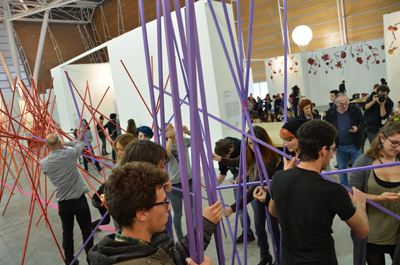





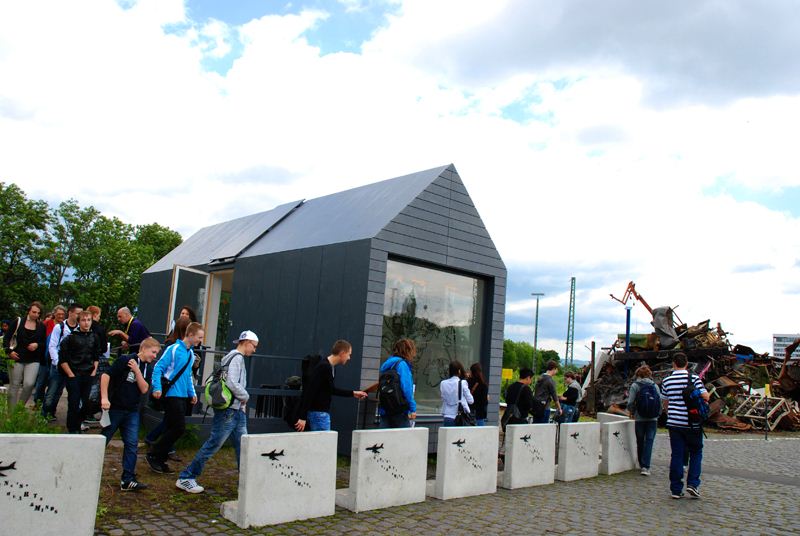
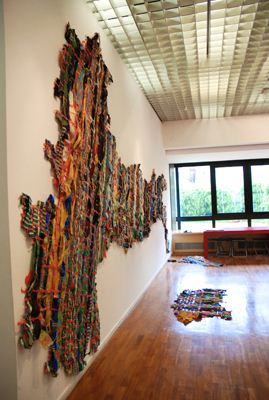







L’educazione attraverso l’arte è tesa a rafforzare la sensibilità emotiva e la consapevolezza razionale per lo sviluppo di personalità non stereotipate, capaci di pensare e rapportarsi in modo autentico, in armonia con l’ambiente in cui agiscono.
L’educazione nei musei non è una funzione marginale e ancillare, ma di vitale importanza per istituzioni pubbliche che si relazionano con il loro territorio e il loro tempo. La conferma storica e internazionale del ruolo fondamentale dei musei e della loro funzione educativa è avvenuta nel 1948 con il primo incontro ICOM a Parigi. A livello nazionale, il Codice dei Beni Culturali e del Paesaggio, all’articolo 101, definisce il museo quale “struttura permanente che acquisisce, cataloga, conserva, ordina ed espone beni culturali per finalità di educazione e di studio”.
Lo studio, la diffusione dei saperi, la divulgazione, la formazione non sono, dunque, solo alcune fra le diverse espressioni della funzione educativa di un museo, sono la finalità stessa del museo.
Lo stato attuale della funzione educativa, fondamento democratico del museo contemporaneo, viene messa in discussione, soprattutto nel nostro Paese, con la diffusa esternalizzazione del personale museale preposto a tale ambito, provocando una regressione culturale che mette al primo posto impostazioni verticistiche, autoreferenziali, legate a logiche di mercato, alla ricerca di un’audience strumentale perché valutata secondo calcoli spesso unicamente numerici. La crisi economica — e ancor più quella finanziaria — ha coinvolto anche le istituzioni culturali con un forte ridimensionamento dei fondi disponibili, determinando orientamenti programmatici che salvaguardano, soprattutto, il valore economico rappresentato dalle opere delle collezioni dei musei. Tale scelta di campo, che penalizza i budget per le attività, rischia di invalidare i risultati conseguiti in anni di ricerca innovativa ed inclusiva, oltre agli esiti delle pratiche fondate sul valore educativo dell’arte del nostro tempo, per altro inscritte nella mission di museo pubblico, dunque del e per il pubblico. Tale situazione rafforza la motivazione, condivisa dai Dipartimenti Educazione, di continuare la ricerca in progress e di proporre una sintesi dell’esperienza nel Manuale di educazione all’arte contemporanea, edito da Prinp – Editoria d’arte 2.0 nel 2017. In questa fase di evoluzione del progetto, di cui non esistono esempi analoghi sul territorio nazionale e internazionale, le esperienze raccolte stanno producendo un concreto interesse di carattere metodologico. Accademie e Università, scuole ed enti culturali riconoscono in ZonArte un punto di riferimento importante, rappresentativo e autorevole per la qualità dei suoi programmi e per la collaborazione interistituzionale che ha saputo costruire negli anni.
ZonArte – lo spazio e il tempo dove il pubblico incontra l’arte contemporanea è il progetto promosso e sostenuto dalla Fondazione per l’Arte Moderna e Contemporanea CRT di Torino, che riunisce i Dipartimenti Educazione delle principali istituzioni piemontesi dedicate all’arte del nostro tempo: Castello di Rivoli Museo d’Arte Contemporanea, GAM Galleria Civica d’Arte Moderna e Contemporanea, Fondazione Merz, PAV Parco Arte Vivente, in collaborazione con Fondazione Sandretto Re Rebaudengo e Cittadellarte Fondazione Pistoletto.